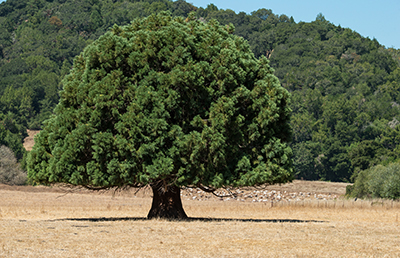Tree Care During a Drought

While we don’t usually worry too much about established trees, extended drought can cause decline and death for young and old trees alike.
Unfortunately, a tree’s age is not a measure of how well it will fare during a drought. You may not even notice the signs of drought stress in your mature trees, as drought stress is first visible at the top center part of the canopy out of view, as leaves start to fall.
The best course of action during an extended drought is to apply water preventatively before you notice your canopy losing foliage. Be sure any watering you do is consistent with local watering restrictions.
Drought Don’ts
There are a few things you should avoid doing to your trees—newly planted or mature—during a drought.
Don’t fertilize trees. Fertilizing pulls water from the roots and forces the tree to expend energy processing the fertilizer which is an additional stressor. It may also push growth that the tree will then have to maintain.
Don’t dig under your tree’s canopy. Digging underneath the canopy during a drought damages the roots and reduces the tree’s capacity to uptake water.
Avoid pruning live branches. Pruning takes away some of the tree’s live tissue and forces the tree to expend energy mending pruning wounds, which is an unnecessary and additional stress to an already drought-stressed tree.
Keep an eye on mulch. While mulch is great for helping keep the soil moist, during a drought this protective barrier can actually hurt your tree by intercepting rainfall and irrigation, diverting it away the roots of the trees.
Young Trees
When talking about “young trees,” that generally means trees planted within the last two years. Young trees do not have as extensive a root system and may be more vulnerable to drought stress. When looking for drought damage, look for signs of leaf drop, yellowing foliage, brown foliage, wilted leaves, or dead branches at the top of the canopy.
Remember, while mulch is good for retaining moisture in the soil, it also can prevent water from soaking down to the roots of your trees. When watering your tree remove the mulch from the top of the root ball and away from the tree. You’ll want to apply about 5 gallons of water for every inch of trunk diameter to the top of the root ball and surrounding soil. For example, if your tree has a 5-inch diameter you’ll want to apply 25 gallons of water. Be sure you’re applying water slowly enough that it’s able to soak down to the roots and not just run off across your parched landscape. Watering twice a week is generally considered enough to keep young trees alive through a drought.

Mature Trees
We don’t generally worry about watering large trees; they seem so stable and constant. However, some types such as wetland trees, fruit trees, and older trees are more susceptible to drought stress. Since damage can be difficult to spot, it’s best to water your tree during a severe drought, regardless of whether you see damage or not.
When watering mature trees, you want to add enough water to wet the top 12 inches of soil. In sandy soil this means adding about an inch of water. You can use tuna or other similar cans placed in the sprinkler’s path to measure. This extra watering should be performed every 2 to 4 weeks during a drought.
Water all soil under the tree’s canopy if possible; this could take quite a while, depending on how you are watering, and may not even be possible if you are under watering restrictions. If you can’t water the entire area beneath the tree canopy, it’s best to completely wet a smaller area as opposed to only barely wetting a large area.
